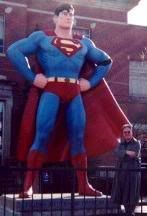| Pop Culture Gadabout | ||
|
Tuesday, September 14, 2010 ( 9/14/2010 07:30:00 AM ) Bill S.  ”I GUESS YOU DON’T GO FOR PRO BONO WORK, HUH?” With the third volume of Saiko Takaki’s manga adaptation of Hideyuki Kikuchi’s Vampire Hunter D (DMP), fans of the long-running horror s-f series get to see how the manga artist handles an extra measure of melancholy. The story of a doomed romance, volume three (which has also been adapted into an anime feature) follows our dhampir bounty hunter as he and a nasty competing family of hunters (“They say no hunter who goes after the same noble as them lives to tell the tale.”) known as the Marcus Clan pursue a noble across the post-apocalyptic landscape. The vamp has seemingly kidnapped the daughter of a village elder, then left the village totally vampirized. Despite this, we’re told by D that of the nobility, only kidnapper Mayerling “has been praised by his subjects for his virtue.” ”I GUESS YOU DON’T GO FOR PRO BONO WORK, HUH?” With the third volume of Saiko Takaki’s manga adaptation of Hideyuki Kikuchi’s Vampire Hunter D (DMP), fans of the long-running horror s-f series get to see how the manga artist handles an extra measure of melancholy. The story of a doomed romance, volume three (which has also been adapted into an anime feature) follows our dhampir bounty hunter as he and a nasty competing family of hunters (“They say no hunter who goes after the same noble as them lives to tell the tale.”) known as the Marcus Clan pursue a noble across the post-apocalyptic landscape. The vamp has seemingly kidnapped the daughter of a village elder, then left the village totally vampirized. Despite this, we’re told by D that of the nobility, only kidnapper Mayerling “has been praised by his subjects for his virtue.”Adding to the complications: vampire Mayerling has hired the mercenary members of a neighboring village to protect him from his pursuers. Within this group is a creature very like the parasitic face on our hero’s left hand, only without as much attachment to the bodies it inhabits. It’s clear that D’s relationship to his own grotesque talking head is a unique one, but then D is not your “typical” dhampir. Where most of these human/vampire hybrids have to lie down in the dirt every six months or so, we’re told that D has gone for five years without succumbing to Sunlight Syndrome. Not so unique is the inevitable huge-breasted femme (does the “D” in this title really stand for our hero’s name -- or the heroines’ cup size?) falls for our lone wolf hero, though this part of the story has an added fillip by making the girl Leila a member of the incestuous Marcus family -- and D’s destruction of her creepy sibs her ultimate rescue. A few more s-f elements beyond our hero’s robotic steed crop up in this outing, as the fleeing noble, we learn late in the story, is heading for a spaceport in the futile hope of being able to escape the bonds of post-apocalyptic Earth. This anticipates the even stronger futureworld setting of the next book in the series, though it really appears to come out of nowhere in the manga. Perhaps the existence of the old spaceport was more clearly set up in the original novel? This small misstep aside, adapter and illustrator Takaki’s treatment of the material is smooth. Her deep-eyed art is especially strong when focusing on her star-crossed lovers, which is as it should be. Reading the third volume for the first time, I found myself thinking of what used to be called “adult westerns” back in the early days of network television: shows like Rawhide or Gunsmoke. They were called “adult” back in the day to differentiate them from the black hat/white hat dichotomies of kids’ westerns, though it’s not as if they were models of ultra-nuanced characterization. In the end, volume three deepens and darkens Kikuchi’s dystopian world but never loses sight of its place as a YA actioner. Which is also as it should be. (First published on Blogcritics.) Labels: sixty-minute manga # | |
|
|

